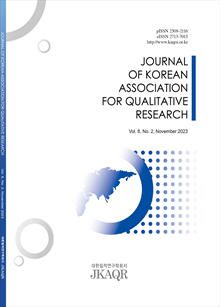간행물
대한질적연구학회지 KCI 등재 Korean Association for Qualitative Research

- 발행기관 대한질적연구학회
- 자료유형 학술지
- 간기 연3회
- ISSN 2508-2116 (Print)2713-7015 (Online)
- 수록기간 2016 ~ 2025
- 주제분류 의약학 > 기타의약학 의약학 분류의 다른 간행물
- 십진분류KDC 512DDC 610
권호리스트/논문검색
3권 (2018년 5월) 4건
1.
2018.05
구독 인증기관 무료, 개인회원 유료
A Qualitative Study on Experience of the Nursing Unit Manager's in Managing Patient Safety Accidents
Purpose: The purpose of this study was to describe the nursing unit manager's experience with patient safety accidents. Methods: Data were collected from April, 2017 to December, 2017 through in-depth interviews with seven unit managers who worked in General wards, OPD or in the ICU of a general hospital. Qualitative content analysis method was used to analyze the data. Results: The following four categories were elicited; dimensions are different from each other, complex feelings about the person after the accident, ambivalence for the accident triggers, leadership learned from accident management. Conclusion: The findings provided valuable informations on the nursing unit managers' experience with patient safety accidents, which held many nursing implications. Based on the findings, it is possible to develop accident management guidelines and the support system for accident management personnels.
4,200원
2.
2018.05
구독 인증기관 무료, 개인회원 유료
Purpose: This study was aimed to provide in-depth understanding of male nurses’ work adaptation experience and suggest future directions for nursing interventions for them by synthesizing individual qualitative findings. Methods: Qualitative meta-synthesis method suggested by Sandelowski and Barroso was utilized. A total of 6 qualitative studies’ findings were synthesized to describe male nurses’ experience of work adaptation in clinical settings. Results: The major task regarding male nurses’ work adaptation was ‘planting himself in the workplace.’ Its contextual and related factors to the task include: extraordinary choice for men, female-centered hierarchical work culture, gender difference vs. interindividual difference, stereotyped view on ‘male’ nurses, strengthening work identity of nursing profession, and dim future even after many years of experience. Conclusion: The findings illuminated the necessity of orchestrated efforts from both female and male nurses to form work environments overcoming gender bias and promoting adaptation of male nurses in clinical settings.
4,000원
3.
2018.05
구독 인증기관 무료, 개인회원 유료
Purpose: This study aimed to provide a comprehensive review of illness experience research study using phenomenological approaches. Methods: Data were searched from the database (CINAHL) under the key word '(Phenomeno*) and lived experience' and the publishing period 'Jan. 2006~Dec. 2016'. A total of 62 articles about first hand experience of patients was selected as final samples. Data were analysed in terms of research method and contents. Results: The chronic illness was the most frequently used disease, and 'van Mannen' method was also the most frequently used. The popular philosophical perspectives were Husserl's phenomenology and Heidegger's hermeneutic phenomenology. As the criteria to ensure truthworthiness, Lincoln & Guba's criteria was the one mostly employed. Conclusion: It was found that the researchers employed various qualitative approaches despite of continued discussion on selecting a proper approach. However, the phenomenological approach was found to be the strongest tool for exploring the lived experience of patients. In this respect, the given approach is warranted for future utilization in nursing research.
4,200원
4.
2018.05
구독 인증기관 무료, 개인회원 유료
Purpose: The research that combines qualitative and quantitative methods are recently received attention in nursing academia and the number of research on mixed method is increased. The purpose of the study was to understand and discuss the application of mixed method research (MMR). Methods: This study provided the concept, research design, justification, and systematic issues of MMR through the literature review and researcher’s analytical thinking. Results: MMR was generally accepted in the literature as a new and comprehensive methodology. MMR was developed from the philosophical foundation on pragmatism. The designs of MMR and notation, mixing strategies, strategies for sampling and data analysis, and validity of MMR were examined. These were continued to be the issues including epistemology and pragmatic stances of MMR, primary point of interface for mixing, the level of interaction between different method (qualitative and quantitative), and more proper langue than ‘mixed’ etc. of MMR. Conclusion: In spite of those issues, MMR is solidified it’s position as multi-strategy research in the aspect of expansion of qualitative and quantitative methods with triangulation. I recommended that the researcher should apply the MMR after considering of epistemological assumptions and possibility evaluation of the synergy effects to his or her research for the merits of extensive results of MMR.
4,000원

